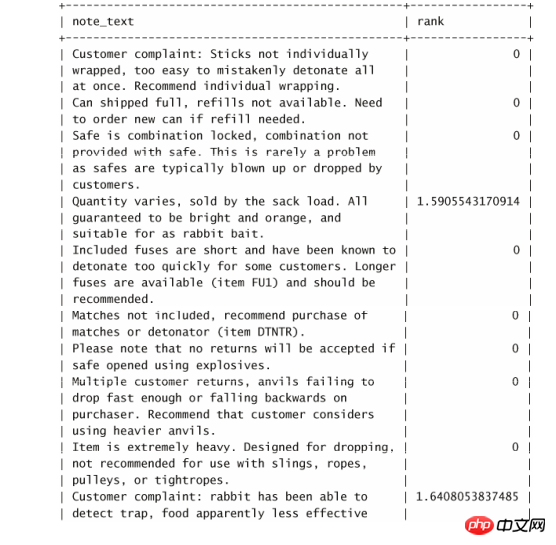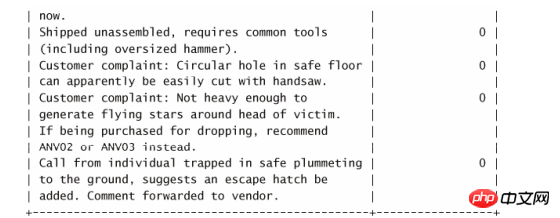Mysql full text search tutorial
After indexing, a full-text search is performed using the two functions Match() and Against(), where Match() specifies the column to be searched and Against() specifies the search expression to use.
Here is an example:
Input:
select note_text from productnotes where match(note_text) against('rabbit');
Output:

Analysis: This SELECT statement retrieves a single column note_text. Due to the WHERE clause, a full text search is performed. Match(note_text) instructs MySQL to search against the specified column, and Against('rabbit') specifies the word rabbit as the search text. Since two rows contain the word rabbit , these two rows are returned.
Use full Match() Description The value passed to Match() must be the same as in the FULLTEXT() definition. If you specify multiple columns, they must be listed (and in the correct order).
Search is not case-sensitive Unless BINARY mode is used, full-text search is not case-sensitive.
The fact is that the search just now can be completed simply with the LIKE clause, as follows:
Input:
select note_text from productnotes where note_text like '%rabbit';
Output:

Analysis: This SELECT statement also retrieves two rows, but in a different order (although this does not always happen).
Neither of the above two SELECT statements contains an ORDER BY clause. The latter (using LIKE ) returns data in an order that is not particularly useful. The former (using full-text search) returns data sorted by how well the text matches. Both lines contain the word rabbit , but the line containing the word rabbit as the 3rd word has a higher rank than the line that contains the 20th word. This is important. An important part of full-text search is sorting the results. Rows with higher ranks are returned first (since these are likely to be the rows you actually want).
To demonstrate how sorting works, look at the following example:
Input:
select note_text match(note_text) against('rabbit') as rank from productnotes;
Output:


Analysis: Here, Match() and Against() are used in the SELECT instead of the WHERE clause. This causes all rows to be returned (since there is no WHERE clause). Match() and Against() are used to create a calculated column (aliased rank ) that contains the rank value calculated by the full-text search. The rank is calculated by MySQL based on the number of words in the row, the number of unique words, the total number of words in the entire index, and the number of rows that contain the word. As you can see, rows that do not contain the word rabbit have rank 0 (and therefore are not selected by the WHERE clause in the previous example). The two lines that do contain the word rabbit each have a rank value, with the line before the word in the text having a higher rank value than the line after the word.
This example helps illustrate how a full-text search excludes rows (excludes those with a rank of 0) and sorts the results (sorting by rank in descending order).
Sort Multiple Search Terms If you specify multiple search terms, those rows that contain most of the matching words will have a higher rank value than those that contain fewer words (or only one match).
As you can see, full text search provides functionality that a simple LIKE search cannot. Also, since the data is indexed, full-text searches are quite fast.
The above is the detailed content of Mysql full text search tutorial. For more information, please follow other related articles on the PHP Chinese website!

Hot AI Tools

Undresser.AI Undress
AI-powered app for creating realistic nude photos

AI Clothes Remover
Online AI tool for removing clothes from photos.

Undress AI Tool
Undress images for free

Clothoff.io
AI clothes remover

AI Hentai Generator
Generate AI Hentai for free.

Hot Article

Hot Tools

Notepad++7.3.1
Easy-to-use and free code editor

SublimeText3 Chinese version
Chinese version, very easy to use

Zend Studio 13.0.1
Powerful PHP integrated development environment

Dreamweaver CS6
Visual web development tools

SublimeText3 Mac version
God-level code editing software (SublimeText3)

Hot Topics
 1377
1377
 52
52
 MySQL: The Ease of Data Management for Beginners
Apr 09, 2025 am 12:07 AM
MySQL: The Ease of Data Management for Beginners
Apr 09, 2025 am 12:07 AM
MySQL is suitable for beginners because it is simple to install, powerful and easy to manage data. 1. Simple installation and configuration, suitable for a variety of operating systems. 2. Support basic operations such as creating databases and tables, inserting, querying, updating and deleting data. 3. Provide advanced functions such as JOIN operations and subqueries. 4. Performance can be improved through indexing, query optimization and table partitioning. 5. Support backup, recovery and security measures to ensure data security and consistency.
 Can I retrieve the database password in Navicat?
Apr 08, 2025 pm 09:51 PM
Can I retrieve the database password in Navicat?
Apr 08, 2025 pm 09:51 PM
Navicat itself does not store the database password, and can only retrieve the encrypted password. Solution: 1. Check the password manager; 2. Check Navicat's "Remember Password" function; 3. Reset the database password; 4. Contact the database administrator.
 How to create navicat premium
Apr 09, 2025 am 07:09 AM
How to create navicat premium
Apr 09, 2025 am 07:09 AM
Create a database using Navicat Premium: Connect to the database server and enter the connection parameters. Right-click on the server and select Create Database. Enter the name of the new database and the specified character set and collation. Connect to the new database and create the table in the Object Browser. Right-click on the table and select Insert Data to insert the data.
 MySQL: Simple Concepts for Easy Learning
Apr 10, 2025 am 09:29 AM
MySQL: Simple Concepts for Easy Learning
Apr 10, 2025 am 09:29 AM
MySQL is an open source relational database management system. 1) Create database and tables: Use the CREATEDATABASE and CREATETABLE commands. 2) Basic operations: INSERT, UPDATE, DELETE and SELECT. 3) Advanced operations: JOIN, subquery and transaction processing. 4) Debugging skills: Check syntax, data type and permissions. 5) Optimization suggestions: Use indexes, avoid SELECT* and use transactions.
 How to view database password in Navicat for MariaDB?
Apr 08, 2025 pm 09:18 PM
How to view database password in Navicat for MariaDB?
Apr 08, 2025 pm 09:18 PM
Navicat for MariaDB cannot view the database password directly because the password is stored in encrypted form. To ensure the database security, there are three ways to reset your password: reset your password through Navicat and set a complex password. View the configuration file (not recommended, high risk). Use system command line tools (not recommended, you need to be proficient in command line tools).
 MySQL and SQL: Essential Skills for Developers
Apr 10, 2025 am 09:30 AM
MySQL and SQL: Essential Skills for Developers
Apr 10, 2025 am 09:30 AM
MySQL and SQL are essential skills for developers. 1.MySQL is an open source relational database management system, and SQL is the standard language used to manage and operate databases. 2.MySQL supports multiple storage engines through efficient data storage and retrieval functions, and SQL completes complex data operations through simple statements. 3. Examples of usage include basic queries and advanced queries, such as filtering and sorting by condition. 4. Common errors include syntax errors and performance issues, which can be optimized by checking SQL statements and using EXPLAIN commands. 5. Performance optimization techniques include using indexes, avoiding full table scanning, optimizing JOIN operations and improving code readability.
 How to create a new connection to mysql in navicat
Apr 09, 2025 am 07:21 AM
How to create a new connection to mysql in navicat
Apr 09, 2025 am 07:21 AM
You can create a new MySQL connection in Navicat by following the steps: Open the application and select New Connection (Ctrl N). Select "MySQL" as the connection type. Enter the hostname/IP address, port, username, and password. (Optional) Configure advanced options. Save the connection and enter the connection name.
 How to execute sql in navicat
Apr 08, 2025 pm 11:42 PM
How to execute sql in navicat
Apr 08, 2025 pm 11:42 PM
Steps to perform SQL in Navicat: Connect to the database. Create a SQL Editor window. Write SQL queries or scripts. Click the Run button to execute a query or script. View the results (if the query is executed).




